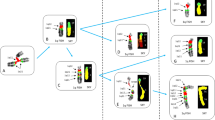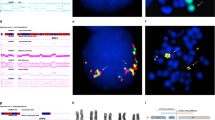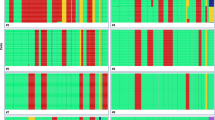Abstract
Tumor cell metaphases of classical Hodgkin's lymphoma (cHL) characteristically display highly rearranged karyotypes with chromosome numbers in the hyperploid range and marked intraclonal variability. The causes of this cytogenetic pattern remain largely unknown. An unusual type of chromosomal abnormality coined as segmental chromosomal aberration (SCA) has been recurrently observed in HL cell lines and was suggested to be associated with ribosomal DNA (rDNA) rearrangements. Moreover, centrosome abnormalities provoking deficient chromosome segregation have been reported in many solid tumors and also in cHL cell lines. Whether SCA, rDNA rearrangements or centrosome abnormalities also occur in primary cHL is not yet known. Thus, we performed extensive molecular cytogenetic and immunohistological studies in two cHL cases. Both cases presented SCA associated with genomic gains of the REL and JAK2 loci, respectively. The SCA involving JAK2 was associated with rDNA rearrangements. The absolute centrosome size of HRS cells in both cases was significantly larger than in non-HRS cells, but the relative centrosome size of HRS cells corrected for nuclear size was in the same range as that of the non-neoplastic cells. These findings demonstrate that the various mechanisms associated with chromosomal instability warrant a more detailed characterization in cHL.
This is a preview of subscription content, access via your institution
Access options
Subscribe to this journal
Receive 12 print issues and online access
$259.00 per year
only $21.58 per issue
Buy this article
- Purchase on Springer Link
- Instant access to full article PDF
Prices may be subject to local taxes which are calculated during checkout


Similar content being viewed by others
References
Drexler HG . Recent results on the biology of Hodgkin and Reed–Sternberg cells. I. Biopsy material. Leuk Lymphoma 1992; 8: 283–313.
Deerberg-Wittram J, Weber-Matthiesen K, Schlegelberger B . Cytogenetics and molecular cytogenetics in Hodgkin's disease. Ann Oncol 1996; 7 (Suppl 4): 49–53.
Atkin NB . Cytogenetics of Hodgkin's disease. Cytogenet Cell Genet 1998; 80: 23–27.
Falzetti D, Crescenzi B, Matteuci C, Falini B, Martelli MF, Van Den Berghe H et al. Genomic instability and recurrent breakpoints are main cytogenetic findings in Hodgkin's disease. Haematologica 1999; 84: 298–305.
Siebert R, Rosenwald A, Staudt LM, Morris SW . Molecular features of B-cell lymphoma. Curr Opin Oncol 2001; 13: 316–324.
Weber-Matthiesen K, Deerberg J, Poetsch M, Grote W, Schlegelberger B . Numerical chromosome aberrations are present within the CD30+ Hodgkin and Reed–Sternberg cells in 100% of analyzed cases of Hodgkin's disease. Blood 1995; 86: 1464–1468.
Ohshima K, Ishiguro M, Ohgami A, Sugihara M, Haraoka S, Suzumiya J et al. Genetic analysis of sorted Hodgkin and Reed–Sternberg cells using comparative genomic hybridization. Int J Cancer 1999; 82: 250–255.
Joos S, Küpper M, Ohl S, von Bonin F, Mechtersheimer G, Bentz M et al. Genomic imbalances including amplification of the tyrosine kinase gene JAK2 in CD30+ Hodgkin cells. Cancer Res 2000; 60: 549–552.
MacLeod RA, Spitzer D, Bar-Am I, Sylvester JE, Kaufmann M, Wernich A et al. Karyotypic dissection of Hodgkin's disease cell lines reveals ectopic subtelomeres and ribosomal DNA at sites of multiple jumping translocations and genomic amplification. Leukemia 2000; 14: 1803–1814.
Küpper M, Joos S, von Bonin F, Daus H, Pfreundschuh M, Lichter P et al. MDM2 gene amplification and lack of p53 point mutations in Hodgkin and Reed–Sternberg cells: results from single-cell polymerase chain reaction and molecular cytogenetic studies. Br J Haematol 2001; 112: 768–775.
Joos S, Menz CK, Wrobel G, Siebert R, Gesk S, Ohl S et al. Classical Hodgkin lymphoma is characterized by recurrent copy number gains of the short arm of chromosome 2. Blood 2002; 99: 1381–1387.
Martin-Subero JI, Gesk S, Harder L, Sonoki T, Tucker PW, Schlegelberger B et al. Recurrent involvement of the REL and BCL11A loci in classical Hodgkin lymphoma. Blood 2002; 99: 1474–1477.
Joos S, Granzow M, Holtgreve-Grez H, Siebert R, Harder L, Martin-Subero JI et al. Hodgkin's lymphoma cell lines are characterized by frequent aberrations on chromosomes 2p and 9p including REL and JAK2. Int J Cancer 2003; 103: 489–495.
Berglund M, Flordal E, Gullander J, Lui WO, Larsson C, Lagercrantz S et al. Molecular cytogenetic characterization of four commonly used cell lines derived from Hodgkin lymphoma. Cancer Genet Cytogenet 2003; 141: 43–48.
Barth TF, Martin-Subero JI, Joos S, Menz CK, Hasel C, Mechtersheimer G et al. Gains of 2p involving the REL locus correlate with nuclear c-Rel protein accumulation in neoplastic cells of classical Hodgkin's lymphoma. Blood 2003; 101: 3681–3686.
Tanaka K, Arif M, Eguchi M, Kyo T, Dohy H, Kamada N . Frequent jumping translocations of chromosomal segments involving the ABL oncogene alone or in combination with CD3-MLL genes in secondary leukemias. Blood 1997; 89: 596–600.
Tanaka K, Kamada N . Segmental jumping translocation in leukemia and lymphoma with a highly complex karyotype. Leuk Lymphoma 1998; 29: 563–575.
Lejeune J, Maunoury C, Prieur M, Van den Akker J . Translocation sauteuse (5p;15q), (8q;15q), and (12q;15q). Ann Genet 1979; 22: 210–213.
Cuthbert G, McCullough S, Finney R, Breese G, Bown N . Jumping translocation at 11q23 with MLL gene rearrangement and interstitial telomeric sequences. Genes Chromosomes Cancer 1999; 24: 295–298.
Pihan GA, Purohit A, Wallace J, Knecht H, Woda B, Quesenberry P et al. Centrosome defects and genetic instability in malignant tumors. Cancer Res 1998; 58: 3974–3985.
Nigg EA . Centrosome aberrations: cause or consequence of cancer progression? Nat Rev Cancer 2002; 2: 815–825.
Krämer A, Neben K, Ho AD . Centrosome replication, genomic instability and cancer. Leukemia 2002; 16: 767–775.
Fukasawa K . Introduction: centrosome. Oncogene 2002; 21: 6140–6145.
Neben K, Giesecke C, Schweizer S, Ho AD, Krämer A . Centrosome aberrations in acute myeloid leukemia are correlated with cytogenetic risk profile. Blood 2003; 101: 289–291.
Schlegelberger B, Metzke S, Harder S, Zühlke-Jenisch R, Zhang Y, Siebert R . Classical, molecular cytogenetics of tumor cells. In: Wegner R (ed). Diagnostic Cytogenetics. New York: Springer-Verlag, 1999 pp 151–185.
Martin-Subero JI, Chudoba I, Harder L, Gesk S, Grote W, Novo FJ et al. Multicolor-FICTION: expanding the possibilities of combined morphologic, immunophenotypic, and genetic single cell analyses. Am J Pathol 2002; 161: 413–420.
Page SL, Shin JC, Han JY, Choo KH, Shaffer LG . Breakpoint diversity illustrates distinct mechanisms for Robertsonian translocation formation. Hum Mol Genet 1996; 5: 1279–1288.
Kolomietz E, Meyn MS, Pandita A, Squire JA . The role of Alu repeat clusters as mediators of recurrent chromosomal aberrations in tumors. Genes Chromosomes Cancer 2002; 35: 97–112.
Pihan GA, Purohit A, Wallace J, Malhotra R, Liotta L, Doxsey SJ . Centrosome defects can account for cellular and genetic changes that characterize prostate cancer progression. Cancer Res 2001; 61: 2212–2219.
Herrmann L, Dittmar T, Erdmann KS . The protein tyrosine phosphatase PTP-BL associates with the midbody and is involved in the regulation of cytokinesis. Mol Biol Cell 2003; 14: 230–240.
Rios RM, Bornens M . The Golgi apparatus at the cell centre. Curr Opin Cell Biol 2003; 15: 60–66.
Zhou H, Kuang J, Zhong L, Kuo WL, Gray JW, Sahin A et al. Tumour amplified kinase STK15/BTAK induces centrosome amplification, aneuploidy and transformation. Nat Genet 1998; 20: 189–193.
Meraldi P, Honda R, Nigg EA . Aurora-A overexpression reveals tetraploidization as a major route to centrosome amplification in p53−/− cells. EMBO J 2002; 21: 483–492.
Acknowledgements
This article is dedicated to Professor Dr Werner Grote, Director of the Institute of Human Genetics of the University Hospital Schleswig-Holstein (Campus Kiel), on the occasion of his 65th birthday. We thank Dorit Schuster and Claudia Becher for their excellent technical assistance and Dr Jochen Heukeshoven for peptide synthesis. Clones for rDNA sequences and the centromere of chromosome 20 were kindly provided by Dr Mariano Rocchi from the University of Bari (Italy, http://www.biologia.uniba.it/rmc).
Author information
Authors and Affiliations
Rights and permissions
About this article
Cite this article
Martín-Subero, J., Knippschild, U., Harder, L. et al. Segmental chromosomal aberrations and centrosome amplifications: pathogenetic mechanisms in Hodgkin and Reed–Sternberg cells of classical Hodgkin's lymphoma?. Leukemia 17, 2214–2219 (2003). https://doi.org/10.1038/sj.leu.2403129
Received:
Revised:
Accepted:
Published:
Issue Date:
DOI: https://doi.org/10.1038/sj.leu.2403129
Keywords
This article is cited by
-
Aurora B kinase in Hodgkin lymphoma: immunohistochemical pattern of expression in neoplastic Hodgkin and Reed-Sternberg cells
Journal of Molecular Histology (2014)
-
RITA, a novel modulator of Notch signalling, acts via nuclear export of RBP-J
The EMBO Journal (2011)
-
3D Telomere FISH defines LMP1-expressing Reed–Sternberg cells as end-stage cells with telomere-poor ‘ghost' nuclei and very short telomeres
Laboratory Investigation (2010)
-
The 3D nuclear organization of telomeres marks the transition from Hodgkin to Reed–Sternberg cells
Leukemia (2009)
-
High expression of several tyrosine kinases and activation of the PI3K/AKT pathway in mediastinal large B cell lymphoma reveals further similarities to Hodgkin lymphoma
Leukemia (2007)



